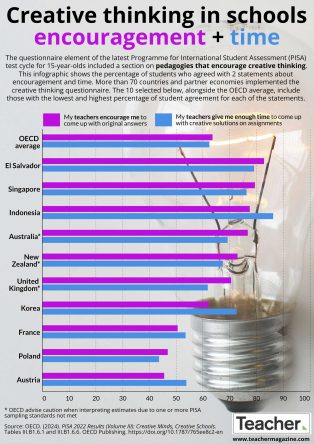This term, thousands of 15-year-olds around Australia are sitting the Programme for International Student Assessment (PISA) – showing how they can apply their knowledge and skills to real-life problems and situations. Rather than providing individual scores, it monitors system or country level performance. Here, we look at what’s new for the 2025 cycle, how the skills assessed link to students’ ability to thrive beyond school, and how teachers and leaders can use PISA insights to inform their own practice and drive school improvement.
Since 2000, more than 3.7 million students from 100 countries and partner economies around the world have been involved in the OECD’s PISA – it’s the world’s largest evaluation of how students apply knowledge in real-world situations.
In Term 3, across Australia, some 20,000 15-year-olds from 788 schools will participate in the 2025 cycle. Students, teachers and principals will also complete a questionnaire that gathers rich data on topics including attitudes to learning, the learning environment, school climate, classroom instruction and staff expertise.
ACER has been appointed as the lead international organisation responsible for the design, development and implementation of PISA 2025, with 10 new countries – from Latin America, Africa and Central Asia – conducting PISA for the first time.
‘ACER helped develop the first 5 cycles and has seen PISA grow in scale from 255,000 students across 32 countries to more than 650,000 students across more than 90 countries and economies,’ it says. ‘It has generated evidence to shape education policies and improve learning outcomes since 2000.’
Here in Australia, the National Assessment Program (NAP) is made up of domestic assessments such as NAPLAN and international ones such as PISA, TIMSS and PIRLS. ACER conducts PISA on behalf of, and with funding from, the Australian and state and territory governments.
Students across the country who are sitting PISA 2025 this term will be shown a special message of support from Australian Olympic skateboarder Ruby Trew.
Preparing students to thrive beyond school
The 3 core subject areas assessed in PISA are mathematics, science and reading, and each assessment cycle has a major focus on one of these domains – in 2025 it will be science.
Rather than a test of curriculum, PISA measures students’ ability to apply the knowledge and skills they’ve learned at school. Can they analyse challenges and opportunities? Can they communicate their ideas effectively? Can they adapt their approach to a problem, based on feedback and new information? In other words, can they transfer and use their skills and knowledge in everyday life?
In PISA reporting you’ll see mention of the ‘National Proficient Standard’. In Australia, this key performance measure has been set at the boundary between Level 2 and 3 on the PISA proficiency scales. Students who don’t meet the National Proficient Standard at 15 are likely to struggle in applying their knowledge and skills to everyday situations beyond school.
So, what does this mean in terms of student capability? Taking a closer look at maths, which was the major focus domain for PISA 2022:
- A Level 6 performer (the highest on the proficiency scale) can work through abstract problems, show creativity, critical thinking and flexible thinking in their solutions, effectively use simulations or spreadsheets, and reflect on their actions.
- A Level 3 performer (meeting National Proficient Standard) can begin using computational-thinking skills, they can solve tasks that require different (but routine) calculations, use spatial visualisation and typically show the ability to handle things like percentages, fractions and decimal numbers.
- A Level 1c performer (the lowest on the proficiency scale) can follow clear instructions about a single step or operation, and deal with questions presented in short, simple text where all the relevant information needed is in a simple, familiar format such as a small table or picture. (De Bortoli et al, 2023).
Learning in the Digital World
Alongside the core subjects, since 2012 the assessment has included an ‘innovative domain’ targeting key interdisciplinary skills. These have included Creative Problem Solving (2012), Collaborative Problem Solving (2015), Global Competence (2018) and Creative Thinking (2022).
In PISA 2025 the innovative domain is Learning in the Digital World (LDW), which focuses on the skills and attitudes needed to effectively use digital tools to tackle open-ended problems. As the OECD (n.d.) notes: ‘While not everyone will become software engineers, jobs of the future will increasingly require people to interact with computational models and simulated realities, and to solve problems using digital tools. Given the rapid rate of technological change, students today must develop a set of broad skills and perspectives that support lifelong learning in novel and unfamiliar digital environments.’
There are 2 competencies being assessed in LDW: self-regulated learning and computational and scientific inquiry practices. The units are open-ended digital environments where students can develop their own strategies, access resources to plug any gaps in their knowledge, and make decisions on how much time they need to spend on different tasks to meet their goals. Along the way, they’ll receive intelligent feedback on their progress and part of the assessment will be how they respond and act on this.
Using PISA insights to drive school improvement
The PISA reports and analysis offer useful insights for teachers and school leaders. Both the Australian and international results are a useful prompt for reflecting on what’s happening in your context.
As we’ve previously shared in Teacher, PISA 2022 highlighted the fact that, in the maths assessment, ‘Australian students performed relatively stronger in uncertainty and data than on change and relationships, quantity, and space and shape,’ and ‘relatively stronger in interpreting, applying and evaluating mathematical outcomes than in formulating situations mathematically, employing mathematical concepts, facts and procedures, and reasoning mathematically,’ (De Bortoli & Earp, 2025).
Questionnaire data offers more food for thought on what might be happening for your students. For example, the 2022 international data reiterated the importance of classroom teachers creating a learning environment where students feel safe and confident in asking questions when they don’t understand what’s being taught (Earp, 2024).
Another student questionnaire topic is mathematics anxiety, which is characterised by feelings of tension, fear or apprehension when they’re faced with mathematics-related tasks. We shared the Australian responses by state and territory in a recent Teacher infographic (Russell, 2025), and these results are a great starting point for a staffroom reflection, PD session and of course a conversation with your own students.
With PISA 2025 now underway, ACER has thanked all the ‘schools and students currently taking part in this valuable exercise to inform the future of education in Australia’. Testing will continue across Australian jurisdictions until 12 September 2025, with findings expected to be released in early September 2026.
References
Earp, J. (2024, December 2). PISA 2022 insights: Student questions, mathematics anxiety, and homework. Teacher magazine. https://www.teachermagazine.com/au_en/articles/pisa-2022-insights-student-questions-mathematics-anxiety-and-homework
De Bortoli, L., & Earp, J. (2023, December 11). Expert Q&A: PISA 2022 with Lisa De Bortoli. Teacher magazine. https://www.teachermagazine.com/au_en/articles/expert-q-a-pisa-2022-with-lisa-de-bortoli
De Bortoli, L., Underwood, C., & Thomson, S. (2023). PISA 2022. Reporting Australia’s results. Volume I: Student performance and equity in education. Australian Council for Educational Research. https://doi.org/10.37517/978-1-74286-725-0.
OECD. (n.d.). Topics: PISA 2025 Learning in the Digital World. https://www.oecd.org/en/topics/sub-issues/learning-in-the-digital-world/pisa-2025-learning-in-the-digital-world.html
Russell, D. (2025, June 13). Infographic: PISA insights – students’ mathematics anxiety. Teacher magazine. https://www.teachermagazine.com/au_en/articles/infographic-pisa-insights-students-mathematics-anxiety
There are 3 examples mentioned in the article in relation to using PISA insights to drive school improvement, all with an associated piece of Teacher content:
- Students’ maths strengths: https://www.teachermagazine.com/au_en/articles/expert-q-a-pisa-2022-with-lisa-de-bortoli
- Mathematics anxiety: https://www.teachermagazine.com/au_en/articles/infographic-pisa-insights-students-mathematics-anxiety
- Student questions: https://www.teachermagazine.com/au_en/articles/pisa-2022-insights-student-questions-mathematics-anxiety-and-homework
With your colleagues, choose one of the examples to focus on. What’s the situation in your own context? How do you know? What are you doing to address any support needs or areas for improvement?



